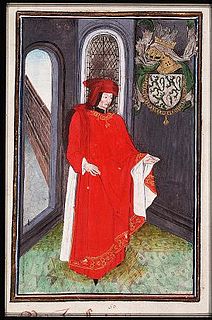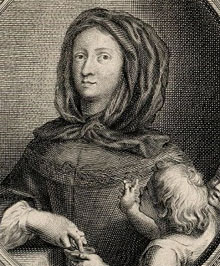Related Research Articles

Princely Count Charles of Arenberg, duke of Aarschot, baron of Zevenbergen, knight of the Order of the Golden Fleece, was the second Princely Count of Arenberg and a leading aristocrat of the Habsburg Netherlands, who served as a courtier, soldier, minister and diplomat.
The Viscounty of Joyeuse was elevated to a Duchy in 1581 by King Henry III of France for his favourite Anne de Joyeuse.
Robert de Melun, viscount of Ghent and marquis of Roubaix, was a nobleman from the Low Countries who fought in the Eighty Years' War.

Jean II de Lannoy or Jan van Lannoy (1410–1493), lord of Lannoy, Lys and Sébourg, was a nobleman from the County of Hainaut who played a prominent role in the politics of the Burgundian Netherlands.

Marie-Christine de Lalaing, or Philippe-Christine de Lalaing, was the daughter of Count Charles II of Lalaing and Marie de Montmorency-Nivelle. She was married to Pierre de Melun, the governor of Tournai. In the absence of her husband, she defended the city of Tournai against Alexander Farnese, Duke of Parma, in 1581.

Jean Sarazin, Latinized Joannes Saracenus (1539–1598) was an abbot of the Benedictine Abbey of St. Vaast, Arras, and the third archbishop of Cambrai.

Remi Drieux, Latinized Remigius Driutius (1519–1594) was the first bishop of Leeuwarden and the second bishop of Bruges.
Jean Bogard was a printer in Leuven and Douai in the 16th and 17th centuries.
Jean Six (1533–1586) was a theologian and bishop of Saint-Omer.

Guillaume de Melun (1588–1635) was a nobleman in the Spanish Netherlands, Governor and Grand Bailiff of the County of Hainaut, and Constable of Flanders, who conspired against the government.

Anne de Melun (1619–1679), widely known as Mademoiselle de Melun, was a noblewoman from the Spanish Netherlands who founded and ran a hospital for the poor in rural France.

The Treaty of Arras of 17 May 1579 was a peace treaty concluded between the Spanish Crown, represented by Alexander Farnese, Duke of Parma, and representatives of the County of Hainaut, the County of Artois, and the cities of Douai, Lille, Orchies and Arras, all members of the Union of Arras, that had been formed the previous January, at the Abbey of St Vaast in Arras. It was a separate peace that formally ended the state of war that had existed between these entities during the Eighty Years' War. The provinces that had formed the Union of Utrecht continued the war.
Baldric of Noyon was the forty-second bishop of Tournai (1099–1112). A chronicle of Arras and Cambrai has mistakenly been attributed to him. His surviving acta include the charter of 1105 by which he awarded the right of presentment for Tielt to the chapter of St Salvator in Harelbeke.
Maximilien Morillon (1516/17–1586) was a senior clergyman in the Habsburg Netherlands who became bishop of Tournai.
Guillaume de Pamele or Willem van Pamele (1528–1591) was a royal office-holder in the Habsburg Netherlands during the Dutch Revolt. He served as president of the Council of Flanders and of the Privy Council of the Habsburg Netherlands.

Franciscus van der Burch (1567–1644) was a bishop of Ghent and archbishop of Cambrai.

Léon Herbo was a Belgian painter; best known for his portraits of women in casual poses and for his portraits of actors and actresses, such as Rose Caron. He also painted genre scenes; many with Orientalist themes. His wife often served as his model.
John of Enghien was the 54th bishop of Tournai and the 69th bishop of Liège in the Low Countries.
Guillaume Le Vasseur, lord of Valhuon, was a nobleman of Artois who served Philip II of Spain as a soldier and diplomat during the Dutch Revolt.
Mathieu Moulart (1536–1600), alternatively Moullart or Moulard, was an abbot and bishop in the Habsburg Netherlands.